Microsoft Surface Pro 3 Review
by Anand Lal Shimpi on June 23, 2014 3:55 AM EST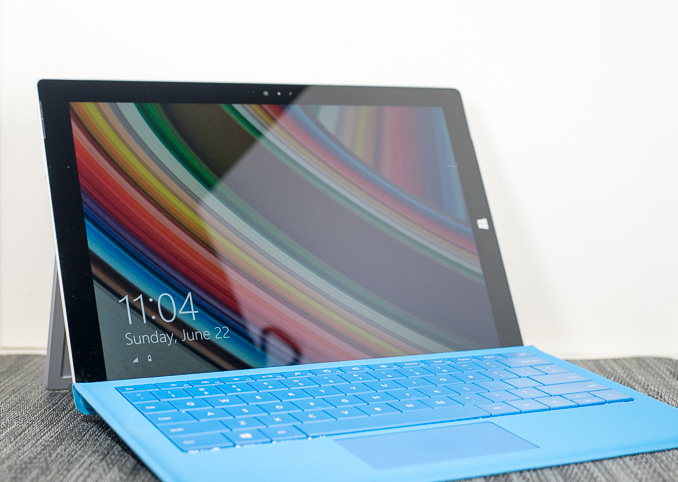
I can't believe it's only been sixteen months since I published our review of the original Microsoft Surface Pro. It feels like longer but that's likely because Surface RT made its sale debut a few months prior to that, and both devices were announced in the Summer of 2012. As far as an end user is concerned however, in February 2013 Microsoft released Surface Pro and proceeded to deliver two more iterations of the hardware in sixteen months. That's three Surface Pros in less than two years.
While the last two were largely similar, the third time is definitely more charming. Surface Pro 3 abandon's Microsoft's 10.6-inch 16:9 form factor in favor of 12-inch 3:2 design. The result is a far less cramped design, and one that does a better job of approximating a normal laptop. To offset the increase in surface area, Surface Pro 3 goes on a substantial diet and shrinks to only 9.1mm thick. Despite using the same SoC as Surface Pro 2, the 3rd generation device is substantially thinner.
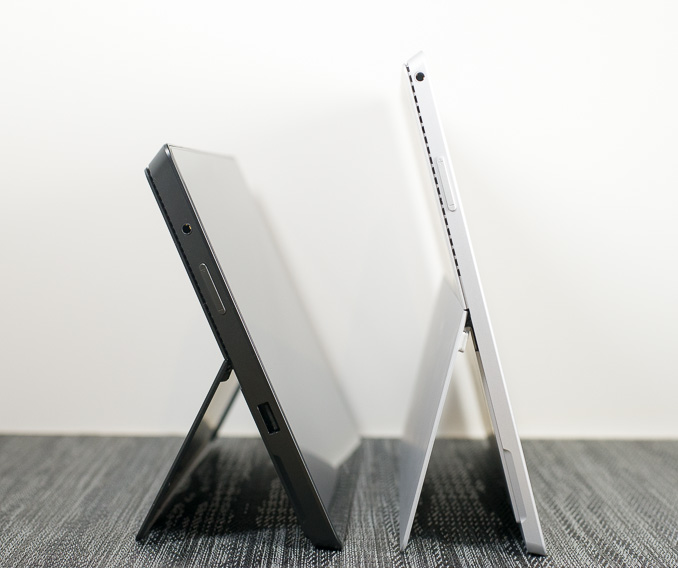
Surface Pro 2 (left) vs. Surface Pro 3 (right)
When Surface first launched, Microsoft set out to prove to the world that it too could build a thoughtfully designed, premium device. Much was said about Microsoft's custom injection moulded Magnesium process, VaporMg, and the extensive testing of the Surface kickstand and hinge. The latter was said to be able to last for over a million actuations.
Surface Pro 3 retains all of the build quality goodness that made the previous designs so unique in the Windows space. The chassis is still made out of Magnesium (although Microsoft curiously has dropped the term VaporMg), and now features the same lighter finish as Surface 2. The design is far more squared off than what we're used to seeing from Apple or any of Google's partners. Surface Pro 3 continues the line's tradition of exuding a more utilitarian design than the softer, more consumption (and consumer?) oriented tablet designs on the market.
| Microsoft Surface Pro Comparison | |||||||||
| Surface Pro 3 | Surface Pro 2 | Surface Pro | |||||||
| Dimensions | 11.5 x 7.93 x 0.36" | 10.81 x 6.81 x 0.53" | 10.81 x 6.81 x 0.53" | ||||||
| Display | 12-inch 2160 x 1440 | 10.6-inch 1920 x 1080 w/ Improved Color Accuracy | 10.6-inch 1920 x 1080 PLS | ||||||
| Weight | 1.76 lbs | 2.0 lbs | 2.0 lbs | ||||||
| Processor | As Configured: Core i5-4300U with HD4400 Graphics (15W Haswell ULT) - Optional Core i3 or Core i7 | Core i5-4200U/4300U with HD4400 Graphics (15W Haswell ULT) | Core i5-3317U with HD4000 Graphics (17W Ivy Bridge) | ||||||
| Cameras | 5MP/5MP (front/rear) | 1.2MP/1.2MP (front/rear) | 1.2MP/1.2MP (front/rear) | ||||||
| Connectivity | 2-stream 802.11ac WiFi | 2-stream 802.11n WiFi | 2-stream 802.11n WiFi | ||||||
| Memory | 4GB or 8GB LPDDR3 | 4GB or 8GB LPDDR3 | 4GB | ||||||
| Storage | 64, 128, 256 or 512GB |
64 or 128GB (4GB RAM) 256GB or 512GB (8GB RAM) |
64GB or 128GB | ||||||
| Battery | 42.0 Wh | 42.0 Wh | 42.0 Wh | ||||||
| Starting Price | $799 ($1299 review configuration) | $899 | $799 | ||||||
Other than the chassis upgrade, there are now more CPU options with the base model starting at $799:
| Microsoft Surface Pro 3 Configuration Options | |||||||||||
| Configuration | $799 | $999 | $1299 | $1549 | $1949 | ||||||
| CPU | Intel Core i3-4020Y | Intel Core i5-4300U | Intel Core i5-4300U | Intel Core i7-4650U | Intel Core i7-4650U | ||||||
| TDP | 11.5W | 15W | 15W | 15W | 15W | ||||||
| Cores/Threads | 2/4 | 2/4 | 2/4 | 2/4 | 2/4 | ||||||
| Frequency Base/Max Turbo | 1.5GHz/- | 1.9/2.9GHz | 1.9/2.9GHz | 1.7/3.3GHz | 1.7/3.3GHz | ||||||
| GPU | Intel HD 4200 | Intel HD 4400 | Intel HD 4400 | Intel HD 5000 | Intel HD 5000 | ||||||
| GPU EUs | 20 | 20 | 20 | 40 | 40 | ||||||
| GPU Frequency Base/Max Turbo | 200/850MHz | 200/1100MHz | 200/1100MHz | 200/1100MHz | 200/1100MHz | ||||||
| Storage | 64GB SSD | 128GB SSD | 256GB SSD | 256GB SSD | 512GB SSD | ||||||
| RAM | 4GB | 4GB | 8GB | 8GB | 8GB | ||||||
The Kickstand: Perfected
From the moment I first used Surface RT, I fell in love with its kickstand. In fact, I went as far as as to say that it was one of the most useful features to ever meet a tablet. The original kickstand was great for desk use. The second generation kickstand added a second stop to improve usability in non-desktop (read: lap-bound) scenarios. With each generation, Microsoft improved its kickstand by adding in the one thing we asked for the last round. With Surface Pro 3, Microsoft perfected the kickstand.
The default opening is still 22-degrees, and the process of getting it open is just as easy as it was before. After you hit that initial stop however, friction in the hinge increases dramatically and with a bit more effort you can push and set the kickstand to any other opening between 22 and 150 degrees. The increased flexibility gives Surface Pro 3 the best kickstand implementation I've seen on any mobile device. Not only can I find a more comfortable position for notebook use, but I can also put the device into tent mode which is great for browser and other tablet workloads. In tent mode Surface Pro 3 is the most comfortable tablet I've ever used.
Lapability
For as much criticism as Microsoft received over Windows 8 and Surface, the company bet big on fixing one of the biggest unsolved problems in mobile. Tablets and notebooks are both great, wouldn't it be amazing if someone could converge the two. Given Microsoft's relative inaction in mobile for the years prior to Windows 8, attempting to leapfrog the market was a very sensible thing to do.
Surface Pro in particular running Windows 8 was designed to be the Swiss Army Knife of mobile computing devices. Whether you wanted a tablet, laptop or even a desktop, Microsoft had a single device it could sell you to serve all three functions. In reality however, Surface always ended up a series of compromises that never seemed to work for the masses. Windows 8 was a disappointment as a tablet OS, and Surface didn't quite work as a laptop, specifically in one's lap. Microsoft referred to the inability for the prior hardware to function ergonomically in the lap as "lapability".
To understand how Surface Pro 3 changed mechanically in pursuit of better "lapability", we need to first understand the difficulties faced by all of the previous Surface designs (Surface RT, Surface Pro, Surface 2 and Surface Pro 2).
The challenge with the Surface design has always been the amount of room it requires on your lap. While you only need to accommodate the room behind the keyboard on a normal laptop, a Surface device requires that much room plus a contact point for the outer edge of the kickstand. At narrow angles, this amounts to another couple inches of lap-room. However, the kickstand opened at a narrow angle forces a less natural display viewing angle. Open the kickstand wider, a feature enabled by Surface Pro 2 (and furthered by Surface Pro 3) and you address the viewing angle concern at the expense of now requiring more room on your lap. You can always pull the device closer to you to compensate, but then you end up sacrificing typing position/comfort.
There's also the issue of stability on your lap. Traditional laptops have a rigid base supporting the device. The Surface devices, on the other hand, don't. The strongest, most rigid part of Surface is the display, which needs but doesn't give much support. Instead the stability duties come from the small contact point of the kickstand and the Type Cover. The Type Cover itself is quite rigid, but the flexible hinge between it and the Surface device was a clear weakspot. In order to allow the Type Cover to function as a cover, its hinge couldn't be totally rigid - it needed to be able to fold around the spine of the tablet. In doing so you get an incredibly useful cover, but a weakened base for using a Surface tablet as a notebook on your lap.
With Surface Pro 3, Microsoft managed to largely address the stability issue and in doing so somewhat addressed the lap-space requirement. The new Type Cover has a second magnetic strip in it that allows you to fold it in even closer to the display when you're in laptop-mode. Doing so completely occludes the bottom bezel, but it eliminates the floppy cover spine from resting on your lap. Now the only parts of the device touching your lap in laptop-mode are rigid elements, which tremendously improves the stability of the design.
As a side effect, by shortening the length of the cover in laptop-mode Microsoft reduces the amount of lap room needed by about an inch. It's not perfect, but it goes a long way to making Surface Pro 3 actually usable on your lap.
The design continues to be a tradeoff however. The new, continuously adjustable kickstand lets you maintain a better viewing angle by opening to wider angles, which require correspondingly more lap area. While the new Type Cover takes up less room, the wider angled kickstand can negate a lot of those savings. The net result is still an ergonomic improvement though. Surface Pro 3 is much easier to position properly on my lap compared to any previous Surface device. While the latter were all ultimately a pain to use on my lap, Surface Pro 3 is passable. I still prefer a laptop, but the gap has been narrowed considerably.
The only other issue that remains with the new foldable Type Cover hinge is the occlusion of the lower bezel on the display. Windows 8 was built around edge gestures, where a swipe in from a bezel would bring up a task switcher, the charms bar or an application-specific menu. By covering the bottom bezel you can no longer use it for edge gestures within an application. Thankfully the top bezel serves the same purpose, but it does require a longer reach than going for the bottom one - something I'd grown used to doing on previous Surface tablets. The occluded bottom bezel forced the relocation of the capacitive Start button to the right side of the panel, which can create issues with accidentally bringing up the Start Screen.


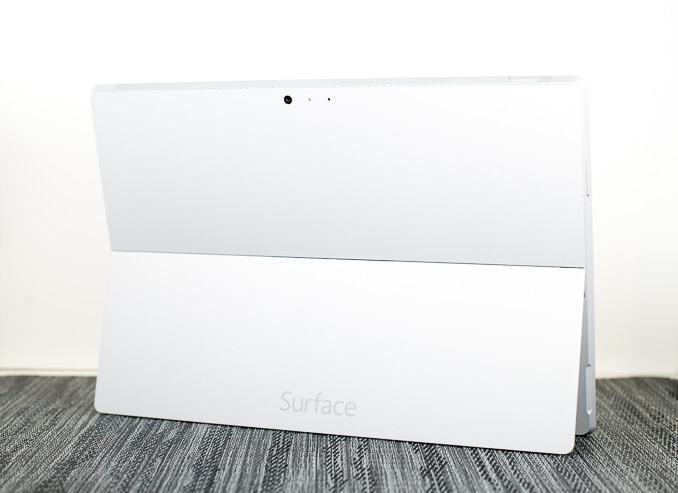
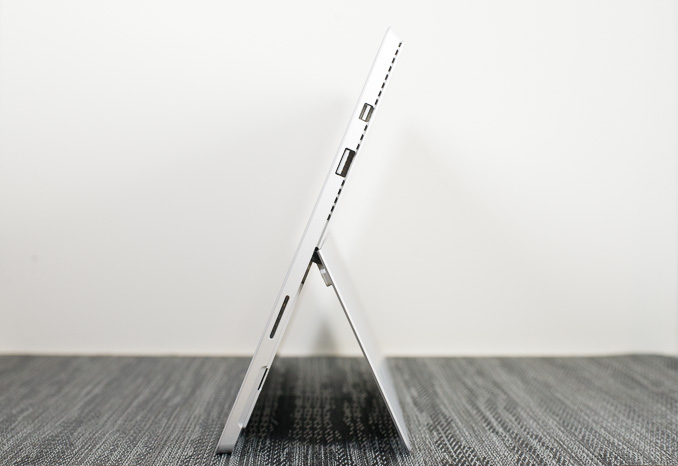
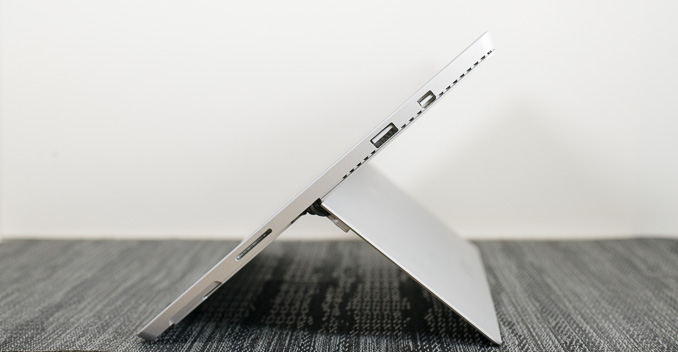

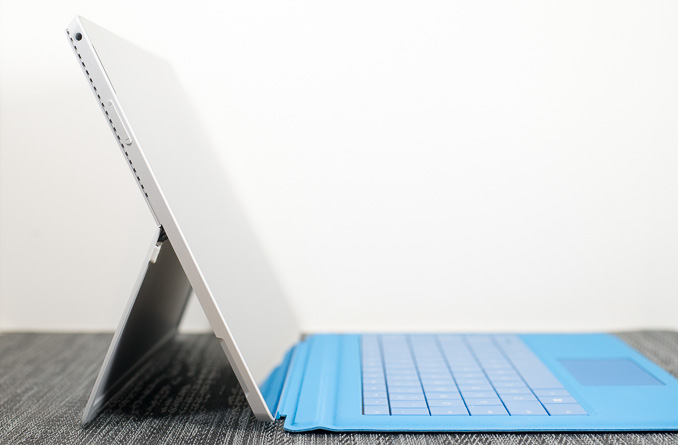
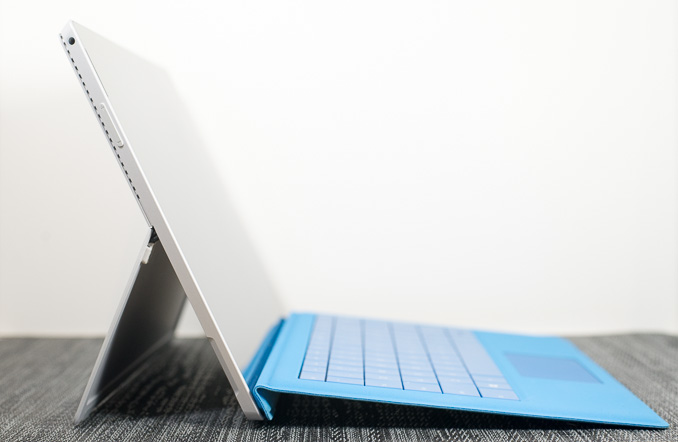








274 Comments
View All Comments
PaulC543 - Thursday, June 26, 2014 - link
"But your claims are just ridiculous... An iPad Air weighs only 1 pound..the iPad mini weighs much less. Adding a tablet to a notebook doesn't add "Several times the weight/bulk" it's not even 1-time the weight and bulk"You misunderstood what I said. What I meant was that carrying a separate tablet and a separate laptop ends up costing more and the combined weight is several times what the Surface is.
An iPad Mini (~$400 and .73lbs) plus a comparable laptop (roughly $1000 and 3.5 lbs) would equal the cost of a Surface Pro and type cover and weigh about 4.25 lbs to the Surface's 1.75lbs. That's several times in anyone's book. Swap the iPad Mini for an Air, and you're spending $400 more still and gaining another 1/4 lb. Throw in the weight of 2 changers, wires, cases, etc.
And sure, there are advantages to having two separate devices, but there's also disadvantages (weight/bulk/integration/file transfers, etc.), so it's 6 to 1, 1/2 dozen the other. But that comes down to personal preference and isn't really what I take issue with - I take issue with the baseless complaints (not necessarily directed at you) that the Surface fails at everything. It doesn't, it's actually quite good at most things, and excels at others. In fact, the Surface has fewer absolute negatives than either laptops or tablets - laptops are too bulky in both design and weight for tablet tasks, and tablets are essential absolutely incapable of laptop-class capabilities. The Surface may require some modest compromises at the extremes of those two use scenarios, but it's still plenty capable at them and covers the entire range in between.
mkozakewich - Monday, June 30, 2014 - link
This isn't targeted towards the masses, really. Like this, I'd also find myself hard-pressed to recommend the Macbook Air to someone who just need a mass-appeal notebook. They can get what they want and save $400 by getting some kind of generic pseudo-ultrabook.Same for the iPad. There are specific cases where I might recommend it, but for most people I'd explore things like the Nexus 7 first.
anandbiatch - Monday, June 30, 2014 - link
Alienwarelolwut?
ymcpa - Monday, June 23, 2014 - link
Are you saying that laptops and tablets aren't compromises? The laptop doesn't have the power of a desktop but add portability. The tablet doesn't have the power, screen size, or keyboard of a laptop but adds more portability and works well with content consumption and light gaming. The question is how much are you giving up in the compromise and what your needs are. As a laptop the surface gives up some comfort on your lap and the keyboard isn't as good because of the shallow keys. You get a lighter device that pretty much has the same processing power as most laptop(obviously excluding gaming laptops with dedicated graphics). As a tablet you are sacrificing weight and battery life but are getting a more power device that can convert to productivity when needed and access to desktop apps. There is an app gap for mobile apps, but that has been steadily improving and you do have access to a desktop browser that will give you access to the content of many apps which aren't yet available on win 8. The other tablets can't access these sites and need the apps to access content.PaulC543 - Tuesday, June 24, 2014 - link
I love the insinuation that tablets and laptops themselves carry no compromises. The suggestion is patently absurd:Tablets - low performance, limited memory and storage, imprecise input, poor integration into a network, severely limited app capabilities, OS update support of maybe 3 years max.
Laptops - large footprint, inefficient input (trackpads), and unless you spend a lot of money thick/bulky, heavy, no touch screen.
*ALL* systems are compromised in one way or another, the Surface line just throws a net around a different set of attributed, and it's neither right or wrong for doing so. If the features it covers aren't important to you, then it's not the right device for you.
Personally, tablets (iPad/Android) are utterly useless to me, while I don't have sufficient need for optimum typing performance to justify the bulk of a clam shell design. So for my needs, the compromises the Surface makes in laptop and tablet modes are minimal, and a small price to pay for the huge area it covers between those two form factors.
In the Surface Pro, I've found very few compromises, and the ones that it does make aren't ones I find particularly limiting.
mkozakewich - Monday, June 30, 2014 - link
All laptops but one aren't the best laptop. All tablets but one aren't the best tablet. By definition.Usability weirdness aside (which is entirely different for every person, positive or negative), the PC internals of the Surface Pro are very competitive. You don't get the absolute max battery life, if that's the one thing that defines value to you, but there are levels for pretty much everything else to make it what you need at a cost similar to other laptops of that power.
Meanwhile, it also makes a pretty good tablet. It's not really supposed to be competing with the iPad; it's really for the people like me who like the idea of a tablet but don't need one and don't want to spend the extra $500 on an iPad.
skiboysteve - Monday, June 23, 2014 - link
Great review! If I had the budget I would buy one. Seems like MS iterated quickly so they could nail it. Wonder what they will try next.For the prolonged performance thermal concerns... I wonder if the office / productivity benchmarks actually mimic the timing of what a user would actually do? Do they just benchmark a ton of office tasks back-to-back-to-back that a user wouldn't normally do that fast? In that case I doubt a user would run into it. Games on the other hand... would be a problem. I wonder if a similar technology like nVIDIA's frame rate limiter would be great here.
mkozakewich - Monday, June 30, 2014 - link
For a long time now, Intel's boosting meant that their cores would work a lot better with proper cooling. The same holds true today: If you docked the Surface Pro 3 with a dock that thermally mates with the backside (Ooooh my) and uses additional, bigger fans to provide better cooling, you'd get far better performance. I think AnandTech actually had articles a couple years ago where they talked about those possibilities.At the moment, I don't think Microsoft's dock has any fans, so it just adds dead weight to the back of the device, which I assume would just cause even worse thermals. Let's hope they add in additional active cooling (or at least good passive cooling, with some kind of fin structure) to their docks in the future. Then they'd at least be worth that price.
djw39 - Monday, June 23, 2014 - link
Anand: still seeing distorted aspect ratio on the pictures in this site's articles, only when viewing in portrait mode on Android (chrome) (Optimus G). When I rotate to landscape the pictures look right.drmyfore - Monday, June 23, 2014 - link
WEIGHT:Surface Pro 3 / 800g (+295g TypeCover=1095g)
Macbook Air 11 / 1.08kg
Macbook Air 13 / 1.35kg
RES:
Surface Pro 3 / 2160*1440
Macbook Air 11 / 1366*768
Macbook Air 13 / 1440*900
THICKNESS:
Surface Pro 3 / 9.1mm (4.8mm TypeCover=13.9mm)
Macbook Air 11 / 17mm
Macbook Air 13 / 17mm
BATTERY LIFE (OFFICAL):
Surface Pro 3 / 9H
Macbook Air 11 / 9H
Macbook Air 13 / 12H
Why not compare with Air 11?